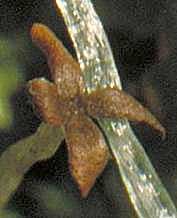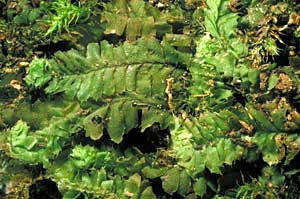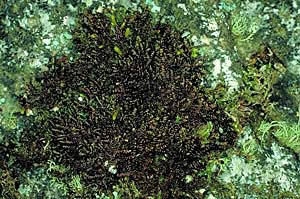
What is a liverwort?
Leafy liverworts
In leafy liverworts the stems-and leaves make up the gametophyte, while the sporophyte is typically a blackish spore capsule (spherical to somewhat ellipsoid) atop a stalk (or seta).
Gametophytes
While the gametophyte of a leafy liverwort is easily described as consisting of "stems with leaves", that simple statement hides considerable complexity. For starters, those stems branch and there are at least twelve different types of branching. At the broadest level there are two basic ways in which branches can form - at the tips of stems or at some distance behind the stem tips. Let's look a little more closely at this. For the sake of clarity, I'll use the term parent stem to mean the stem from which a branch will grow.
A branch that forms at the tip of the parent stem will develop from one of the parent stem's surface cells. Such a branch will grow smoothly from the parent stem, typically at an angle of 45-60 degrees with the parent stem.
Now, what of branch development some distance behind the tip of the parent stem. In the great majority of cases the new branch will develop from cells within the parent stem, not from a surface cell. In doing so, the embryonic branch must push through the surface of the parent stem. In doing so it creates a collar, of parent stem tissue, around the base of the new branch. You don't see such a collar around the base of a branch that grows from the tip of the parent stem. Moreover, the branch that grows through the collar is typically at right angles to the parent stem. In the genus Haplomitrium, branches are formed behind the tip of the parent stem but in this genus the branches develop from surface cells, so producing no collar. The genus Haplomitrium has few species and this genus differs from the majority of leafy liverwort genera in various ways.
|
A leafy liverwort typically has leaves of two sizes, arranged in three rows along the stem. The larger leaves (called lateral leaves) grow in two rows, along opposite sides of the stem. The great majority of leafy liverworts are prostrate plants and grow along some substrate (e.g. soil, bark, leaves, rock). In such a growth form the lateral leaves are parallel to the substrate and the third row of leaves are on the underside of the stem - which explains why they are often called underleaves. The underside of the liverwort is also referred to as the ventral side (with the upper side being the dorsal side), so that you'll also see the term ventral leaves for the underleaves - and a third term is amphigastria. Well, you don't need to memorise them all, it's the principal that counts, but all three names are in fairly common use so it's worth explaining them here. That way you won't be puzzled when you come across one of these terms in a liverwort book. The coplanar arrangement of the lateral leaves gives leafy liverworts a "flat" look that is rare in mosses.
The points made in the previous paragraph are true for the majority of leafy liverworts. However, the appearance of the word "typically" should immediately warn you that there are exceptions. That's particularly the case with the underleaves. They may be well-developed, rudimentary or even absent. In some cases the underleaves will be joined to neighbouring lateral leaves. While underleaves are usually smaller than the lateral leaves (and often of a different shape) there are examples where there is little to distinguish the underleaves from the lateral leaves. Then there may also be differences between the general stems and those that produce the sexual organs. For example, in the genus Cephalozia the underleaves are present near the archegonia (the female, egg-producing organs). On the non-archegonial stems you find tiny slime-producing cells where you could expect underleaves.
In some leafy liverworts even the lateral leaves are quite small. An example is the genus Zoopsis ![]() in which each lateral leaf typically consists of just a few cells. The lateral leaves are little more than "stubs" on the stem.
in which each lateral leaf typically consists of just a few cells. The lateral leaves are little more than "stubs" on the stem.
There is variation in the way leaves are arranged on the stem. In many leafy species the lateral leaves meet the stems at an oblique angle, with the leading edge (i.e. the one nearer the stem tip) of one leaf overlapping the trailing edge of the next leaf in the row. There are two ways in which this overlapping can occur, as shown by the following diagrams. In each the view is of the dorsal side and the tip of the stem is towards the left of the screen. In the diagram on the left you can easily see the leading edge of each leaf, while in the diagram on the right you can easily see the trailing edge of each leaf. Technically those leaf arrangements are referred to as incubous and succubous, respectively.
|
The other basic way in which a leaf can meet the stem is at right angles to the main axis, in which case we call it a transverse attachment. There are several other arrangements which are slight modifications of the three basic ones just described. Depending on species the lateral leaves will be incubous, transverse or succubous - but the succubous arrangement is the most common for lateral leaves. Underleaves are always transversely attached.
The individual leaves are small and mostly just one cell thick, making them translucent. In some species the bases of the leaves may be more than one cell thick. While many of the leafy liverworts have green leaves, species in the genus Frullania (right) commonly have reddish-brown leaves . Frullania is a very widespread and common genus that is found in many natural and urban areas.
The leaves themselves vary greatly in shape, depending on species. The leaves range from fairly simple, rounded shapes to heavily divided. The margins may be smooth to toothed to hairy. You'll find far greater leaf diversity in liverworts than you will in mosses. There's more about the leaves themselves in the LEAF section.
In leafy liverworts the anchoring rhizoids may appear in various places. They are most commonly found growing from the undersides of the horizontal stems. In such cases they may be found spread evenly along the stem or, in some species, in bunches beneath points where the leaves grow out from the stems. They may also be found growing from the underleaves, or in place of the underleaves and in yet some other species they grow from the main leaves. Though mostly colourless, you can also find red rhizoids in the leafy liverworts. In most cases the rhizoids are fairly simple in form, but there are species in which the ends of the rhizoids are swollen or branched or multicellular. The swollen ends in some species contain fungal symbionts.
Sporophytes
This photograph ![]() shows a number of sporophytes of the species Lophocolea semiteres. The colourless stalks or setae are highly obvious and atop a few of those setae you can see unopened black spore capsules. The spore capsules of leafy liverworts complete their development while still seated on the gametophyte. When the spores in a capsule are mature the stalk elongates and raises the capsule above the gametophyte. Therefore the black capsules in the photo contain mature spores. Once raised, a capsule typically splits along four lines of weakness. It then opens, the four sections folding outward to finally resemble a small star atop the seta, leaving the spores and elaters exposed to the air and readily dispersed by even the slightest of breezes. You can find out more in the SPOROPHYTE DEVELOPMENT SECTION and the DISPERSAL SECTION
shows a number of sporophytes of the species Lophocolea semiteres. The colourless stalks or setae are highly obvious and atop a few of those setae you can see unopened black spore capsules. The spore capsules of leafy liverworts complete their development while still seated on the gametophyte. When the spores in a capsule are mature the stalk elongates and raises the capsule above the gametophyte. Therefore the black capsules in the photo contain mature spores. Once raised, a capsule typically splits along four lines of weakness. It then opens, the four sections folding outward to finally resemble a small star atop the seta, leaving the spores and elaters exposed to the air and readily dispersed by even the slightest of breezes. You can find out more in the SPOROPHYTE DEVELOPMENT SECTION and the DISPERSAL SECTION
 There are some open spore capsules in the above photo, but are mostly in the more shaded areas, so making them hard to see. Whenever you see a group of leafy liverwort sporophytes it pays to look amongst them for open capsules. Here is a considerable enlargement of part of the previous photo showing an open capsule. You can also see the seta of another sporophyte behind the open capsule.
There are some open spore capsules in the above photo, but are mostly in the more shaded areas, so making them hard to see. Whenever you see a group of leafy liverwort sporophytes it pays to look amongst them for open capsules. Here is a considerable enlargement of part of the previous photo showing an open capsule. You can also see the seta of another sporophyte behind the open capsule.
Once a seta has elongated it is only a short time before the capsule opens and, once the capsule has opened, the spores are all dispersed fairly quickly. That translucent seta beneath a liverwort capsule is quite flimsy and stays upright for a only short time. Typically it collapses within a day after the opening of the capsule. This photo ![]() shows a number of collapsed setae. Usually there are many sporophytes on each gametophyte and, at any given time, they are not all at the same stage of development. Thus a given individual liverwort can produce numerous sporophytes over many days. So, while each individual, mature sporophyte is short-lived, the total spore dispersal period for or a single liverwort plant can last many days.
shows a number of collapsed setae. Usually there are many sporophytes on each gametophyte and, at any given time, they are not all at the same stage of development. Thus a given individual liverwort can produce numerous sporophytes over many days. So, while each individual, mature sporophyte is short-lived, the total spore dispersal period for or a single liverwort plant can last many days.
![An Australian Government Initiative [logo]](/images/austgovt_brown_90px.gif)




